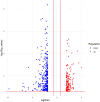Microarray-based detection and expression analysis of drug resistance in an animal model of peritoneal metastasis from colon cancer
- PMID: 38609535
- PMCID: PMC11499332
- DOI: 10.1007/s10585-024-10283-5
Microarray-based detection and expression analysis of drug resistance in an animal model of peritoneal metastasis from colon cancer
Abstract
Chemotherapy drugs efficiently eradicate rapidly dividing differentiated cells by inducing cell death, but poorly target slowly dividing cells, including cancer stem cells and dormant cancer cells, in the later course of treatment. Prolonged exposure to chemotherapy results in a decrease in the proportion of apoptotic cells in the tumour mass. To investigate and characterize the molecular basis of this phenomenon, microarray-based expression analysis was performed to compare tHcred2-DEVD-EGFP-caspase 3-sensor transfected C-26 tumour cells that were harvested after engraftment into mice treated with or without 5-FU. Peritoneal metastasis was induced by intraperitoneal injection of C-26 cells, which were subsequently reisolated from omental metastatic tumours after the mice were sacrificed by the end of the 10th day after tumour injection. The purity of reisolated tHcred2-DEVD-EGFP-caspase 3-sensor-expressing C-26 cells was confirmed using FLIM, and total RNA was extracted for gene expression profiling. The validation of relative transcript levels was carried out via real-time semiquantitative RT‒PCR assays. Our results demonstrated that chemotherapy induced the differential expression of mediators of cancer cell dormancy and cell survival-related genes and downregulation of both intrinsic and extrinsic apoptotic signalling pathways. Despite the fact that some differentially expressed genes, such as BMP7 and Prss11, have not been thoroughly studied in the context of chemoresistance thus far, they might be potential candidates for future studies on overcoming drug resistance.
Keywords: Apoptosis; BMP7; Cell survival; Chemoresistance; Chemotherapy; Prss11.
© 2024. The Author(s).
Conflict of interest statement
The authors declare no competing interests.
Figures


Similar articles
-
Downregulation of lncRNA CCAT1 enhances 5-fluorouracil sensitivity in human colon cancer cells.BMC Mol Cell Biol. 2019 Apr 23;20(1):9. doi: 10.1186/s12860-019-0188-1. BMC Mol Cell Biol. 2019. PMID: 31039730 Free PMC article.
-
Comparison of gene expression in HCT116 treatment derivatives generated by two different 5-fluorouracil exposure protocols.Mol Cancer. 2004 Apr 26;3:11. doi: 10.1186/1476-4598-3-11. Mol Cancer. 2004. PMID: 15109396 Free PMC article.
-
Knockdown of PRDX2 sensitizes colon cancer cells to 5-FU by suppressing the PI3K/AKT signaling pathway.Biosci Rep. 2017 May 11;37(3):BSR20160447. doi: 10.1042/BSR20160447. Print 2017 Jun 30. Biosci Rep. 2017. PMID: 28432271 Free PMC article.
-
The combination of FLCWK with 5-FU inhibits colon cancer and multidrug resistance by activating PXR to suppress the IL-6/STAT3 pathway.J Cell Mol Med. 2024 Nov;28(21):e70185. doi: 10.1111/jcmm.70185. J Cell Mol Med. 2024. PMID: 39495702 Free PMC article.
-
MicroRNA-23a antisense enhances 5-fluorouracil chemosensitivity through APAF-1/caspase-9 apoptotic pathway in colorectal cancer cells.J Cell Biochem. 2014 Apr;115(4):772-84. doi: 10.1002/jcb.24721. J Cell Biochem. 2014. PMID: 24249161
References
-
- Bray F et al (2018) Global cancer statistics 2018: GLOBOCAN estimates of incidence and mortality worldwide for 36 cancers in 185 countries. Cancer J Clin 68(6):394–424 - PubMed
-
- Mutch MG (2016) The Surgical Management of Colon Cancer. The ASCRS textbook of colon and rectal surgery. Springer, Berlin, pp 443–470
-
- Vogel JD et al (2017) The American society of colon and rectal surgeons clinical practice guidelines for the treatment of colon cancer. Dis Colon Rectum 60(10):999–1017 - PubMed
MeSH terms
Substances
LinkOut - more resources
Full Text Sources
Medical
Research Materials

